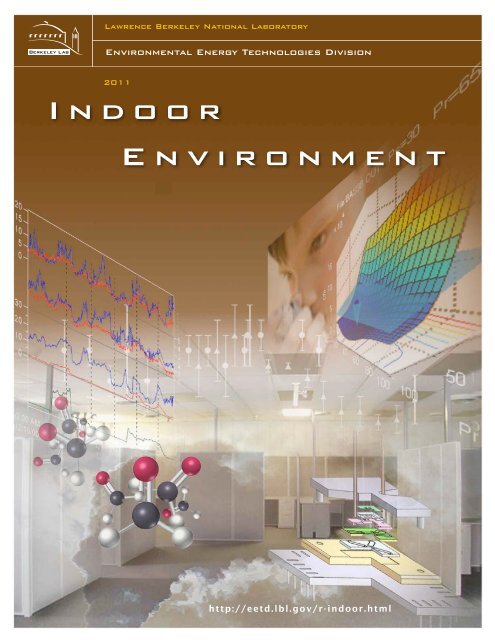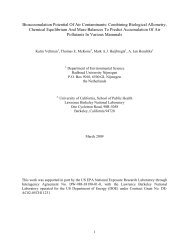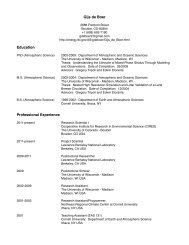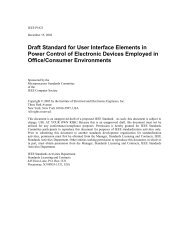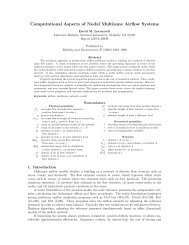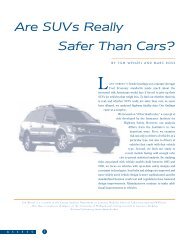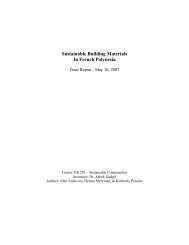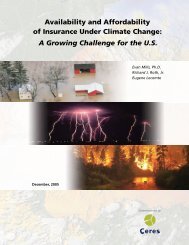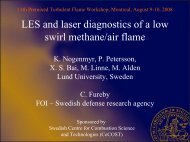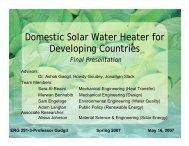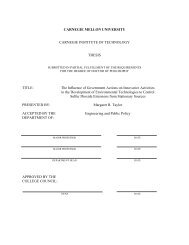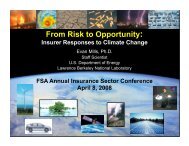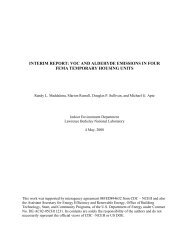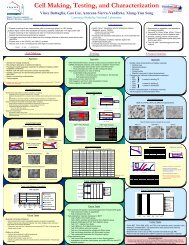Indoor Environment Department - Environmental Energy ...
Indoor Environment Department - Environmental Energy ...
Indoor Environment Department - Environmental Energy ...
Create successful ePaper yourself
Turn your PDF publications into a flip-book with our unique Google optimized e-Paper software.
Lawrence Berkeley National Laboratory<br />
<strong>Environment</strong>al <strong>Energy</strong> Technologies Division<br />
2011<br />
I n d o o r<br />
E n v i r o n m e n t<br />
http://eetd.lbl.gov/r-indoor.html
<strong>Indoor</strong> <strong>Environment</strong> <strong>Department</strong><br />
• Airflow<br />
• Air Cleaning<br />
• Air Infiltration<br />
• Air Quality<br />
• Building-Related Symptoms<br />
Significance of <strong>Indoor</strong> <strong>Environment</strong>s<br />
People spend approximately 90 percent of their time<br />
indoors. Characteristics of the indoor environment that<br />
affect people’s comfort, health, and work performance<br />
include thermal conditions, concentrations of chemical<br />
and biological pollutants, outdoor air supply rates,<br />
acoustic conditions, and lighting conditions. Much of<br />
the energy use of buildings, such as all of the energy<br />
used for heating, ventilating, and air conditioning, is for<br />
maintaining acceptable indoor environmental conditions.<br />
Many of the changes that can be made to building<br />
designs and operational practices to reduce energy<br />
consumption will modify aspects of indoor environmental<br />
quality with potential impacts, positive or negative,<br />
on comfort, health, and performance. Consequently,<br />
building energy performance and indoor environmental<br />
quality must be addressed in a coordinated manner.<br />
Research Areas<br />
• Ducts and Duct Sealing<br />
• Heating and Air Conditioning<br />
• <strong>Indoor</strong> Chemistry<br />
• <strong>Indoor</strong> <strong>Environment</strong>al Quality<br />
• <strong>Indoor</strong> Pollutants<br />
Building Infiltration and Ventilation<br />
Relative Performance<br />
Ventilation Rate<br />
• Modeling Pollutant Transport<br />
• Respiratory Problems, Mold,<br />
Allergies, Asthma<br />
• Sick-Building Syndrome<br />
• Ventilation<br />
<strong>Indoor</strong> <strong>Environment</strong> <strong>Department</strong> Research Goals<br />
• Reducing the energy used for thermally conditioning<br />
and distributing ventilation air in buildings<br />
• Improving indoor air quality (IAQ), thermal<br />
comfort and the health and productivity of building<br />
occupants<br />
• Improving the scientific understanding of factors<br />
and processes affecting indoor air quality, pollutant<br />
exposures, and health effects<br />
• Developing the most effective ways of reducing<br />
indoor exposures to very hazardous chemical and<br />
biological agents in the event of accidental or<br />
intentional releases<br />
• Developing input for codes and standards that<br />
improve indoor environmental and energy perfor<br />
mance of buildings<br />
Building infiltration and ventilation affects energy consumption,<br />
concentrations of indoor air pollutants, and occupant health and<br />
performance. Research is conducted to characterize the rates of<br />
ventilation in buildings and to elucidate how ventilation affects<br />
energy consumption, indoor air quality, health, and performance.<br />
Ventilation technologies and control strategies that improve indoor<br />
air quality and minimize energy use are evaluated and developed.<br />
Models of building ventilation are developed. Input is provided for<br />
the development of building ventilation standards and codes.
Impacts of <strong>Indoor</strong> <strong>Environment</strong>al Quality on Health,<br />
Comfort and Performance<br />
Life-Cycle Impact Assessment<br />
Statistical Data Analyses<br />
Knowledge of the relationship between indoor<br />
environmental quality and people’s health, comfort,<br />
and performance provides the critical foundation for<br />
ventilation and indoor air quality standards and for<br />
many decisions about how to design, operate, use,<br />
and maintain buildings. To assess how the indoor<br />
pollutants, thermal conditions, and related features<br />
of buildings affect health, work performance, school<br />
performance, and school absence, the <strong>Department</strong><br />
performs epidemiologic studies and experiments in<br />
buildings and completes critical reviews and metaanalyses<br />
of existing data.<br />
Life-cycle assessment addresses a broad range of impacts for technologies,<br />
industrial processes, and products in order to determine their propensity to<br />
consume natural resources or generate pollution. The term “life cycle” refers to<br />
the need to include all stages of a product or service—raw material extraction,<br />
manufacturing, distribution, use, and disposal. A life-cycle impact assessment<br />
(LCIA) provides characterization factors to compare the impacts of different<br />
product/service components. The <strong>Department</strong>'s research program is developing<br />
methods to study the life-cycle health and environmental impacts, as well as<br />
economic feasibility and performance of the various pathways from sunlight to<br />
energy, with a current emphasis on biofuels. The department is also assessing the<br />
environmental, economic, and health consequences of the construction, operation,<br />
and end-of-life treatment of buildings. A particular emphasis is on the<br />
improved knowledge of the interactions and potential trade-offs among<br />
economic, environmental, and health burdens linked to commercial and residential<br />
building energy performance and the environmental and economic impacts of<br />
building materials through the associated supply chains and building-use phase.<br />
Data analysis, model uncertainty propagation, and<br />
decision analysis are integral components of the<br />
<strong>Department</strong>’s research. We have developed innovative<br />
tools for analyzing data from experiments, propagating<br />
uncertainties of model inputs to output predictions, and<br />
decision making when faced with uncertain outcomes.<br />
Computational tools applied include Bayes Monte Carlo<br />
uncertainty analysis, conditional and regression trees,<br />
value-of-information analyses, and various multivariate<br />
and meta-analysis techniques. Recent applications<br />
include explaining data from various observational and<br />
field experiments, epidemiological studies (e.g., the<br />
effects of dampness and mold on health), and environmental<br />
pollutant fate predictions.
Sensors and Sensor Networks<br />
Modeling<br />
Codes, Standards, and Guidelines<br />
The <strong>Department</strong> develops and evaluates sensors for various environmental<br />
and energy applications. Examples of related research<br />
include refining and miniaturizing a personal particle exposure<br />
monitor, evaluation of the accuracy of carbon dioxide sensors used<br />
for control of building ventilation, and evaluation of sensor systems<br />
that determine the number of occupants in a building or building<br />
zone, which may be used to prescribe the amount of ventilation<br />
needed to maintain indoor air quality. The <strong>Department</strong> also has<br />
active research programs in designing environmental sensor<br />
networks and interpreting measurements from them. For example,<br />
we have a program on interpreting readings from various building<br />
sensors (energy, temperature, CO2, etc.) to detect when and where a<br />
building energy system is operating properly or faulting. We also<br />
have a program to develop probabilistic algorithms to determine the<br />
optimal placement of air monitoring sensors to detect and locate a<br />
pollutant release in a building.<br />
Mathematical and statistical modeling are essential components<br />
of the <strong>Department</strong>’s research. The <strong>Department</strong><br />
holds an important scientific philosophy in how models<br />
are developed and employed in our research. In a<br />
nutshell, the complexity of a model should be regulated<br />
by the research question being explored. Questions we<br />
ask ourselves when developing models include “What level<br />
of detail is needed to answer this question? What are the<br />
model-input uncertainties and variability? What data exist<br />
to confirm or refute the model predictions? Our scientists<br />
sit on various National Academy and U.S. <strong>Environment</strong>al<br />
Protection Agency Science Advisory Panels to provide<br />
guidance on the appropriate use of models for environmental<br />
studies and regulatory purposes. Models used in<br />
our research include multimedia environmental fate and<br />
exposure models, building multi-zone airflow and pollutant<br />
dispersion models, computational fluid dynamics<br />
models, and various statistical and regression models.<br />
Codes, standards, and guidelines are important tools for<br />
changing industry practice in a manner that improves<br />
environmental quality and reduces energy consumption.<br />
The <strong>Department</strong> provides extensive technical input to<br />
organizations responsible for codes, standards, and guidelines.<br />
In many cases, <strong>Department</strong> staff provide the initiative and leadership for the development of new<br />
professional consensus standards and guidelines by organizations such as the American Society of Heating,<br />
Refrigerating, and Air Conditioning Engineers (ASHRAE) and the American Society of Testing and Materials.
Thermal Distribution<br />
Thermal distribution is the process of moving heat throughout a building for space<br />
heating or cooling, such as the movement of heated or cooled air through ducts to<br />
maintain thermal comfort. The goal of the <strong>Department</strong>’s thermal distribution<br />
research is to ensure that thermal distribution systems operate as intended with<br />
minimal energy loss. Research and technology transfer topics include diagnostic<br />
methods for evaluating thermal distribution performance in field settings, test<br />
procedures for certifying component performance, design guidance for practitioners,<br />
and improved thermal distribution technologies. Considerable emphasis is<br />
placed on technical contributions to related aspects of codes and standards.<br />
<strong>Indoor</strong> Pollutants: their Sources, Transport, and<br />
Chemical Reactions<br />
Research is performed to characterize the concentrations of air pollutants<br />
in buildings and all of the factors that determine these concentrations.<br />
Surveys in populations of buildings establish baseline levels of<br />
pollutants and related factors such as outdoor air ventilation rates.<br />
Laboratory research quantifies the emission rates of pollutants from<br />
various indoor sources. <strong>Indoor</strong> chemical reactions that transform and<br />
create new pollutants are investigated. <strong>Indoor</strong> air and pollutant transport<br />
processes and their impacts on pollutant exposures are evaluated. The<br />
transport of pollutants from outdoors to indoors is also investigated.<br />
Related measurement techniques are developed or improved. Models are<br />
developed and employed to predict pollutant emission rates, transport<br />
processes, chemical reactions, pollutant concentrations, and exposures.<br />
Pollutant Exposure Assessment and Modeling<br />
he <strong>Department</strong> characterizes and models human exposures to a broad<br />
range of harmful substances, we conduct research to understand and<br />
quantify the emissions, dispersion, and fate of pollutants from indoor<br />
and outdoor sources. We work on current and emerging technologies<br />
for anticipating and monitoring contaminant exposures for both human<br />
and ecological receptors. Current research focuses the physical and<br />
chemical processes that govern pollutant concentrations and exposures.<br />
We also develop, evaluate, and apply cumulative exposure measurements<br />
and models in health-risk assessments. The motivation for this<br />
research is to understand and reduce the potential human health and<br />
ecological effects of energy, industrial, and agricultural systems.<br />
<strong>Energy</strong>-efficient technologies and strategies for reducing<br />
unacceptable exposures to air pollutants are a major area<br />
of emphasis. Related research topics include advances in<br />
ventilation system design and operation, pollutant source<br />
identification and control measures, particle filtration, gas<br />
phase air cleaning, and applications of pollutant sensors.<br />
The research scope includes control measures for reducing<br />
risks from accidental or intentional indoor or outdoor<br />
releases of highly toxic chemical and biological agents.
•<br />
•<br />
•<br />
•<br />
•<br />
•<br />
•<br />
•<br />
•<br />
Examples of Achievement<br />
Examples of recent achievements of the <strong>Indoor</strong><br />
<strong>Environment</strong> <strong>Department</strong> are listed below.<br />
Characterized the relationship between rates of<br />
outdoor air supply to office buildings and the office<br />
worker’s health symptoms and work performance<br />
Quantified the relationship between dampness and<br />
mold in homes and prevalence of asthma and<br />
respiratory health effects<br />
Identified the opportunity to simultaneously<br />
improve comfort, health, and building energy<br />
performance through better control of air temperatures<br />
in offices<br />
Evaluated technologies for measuring and controlling<br />
office building ventilation rates, providing<br />
guidance for equipment selection<br />
Developed an improved method for measuring the<br />
rates of air leakage in residential duct systems<br />
Led the development of the first ASHRAE ventilation<br />
and indoor air quality standard for homes<br />
Quantified the emission rates of air pollutants from<br />
office equipment<br />
Evaluated the energy performance of residential air<br />
handling systems, leading to changes in fan<br />
efficiency specifications in California Title 24 codes<br />
and to the development of a new ASHRAE standard<br />
on residential air handler cabinet leakage<br />
Developed extensive technical guidance for the<br />
ongoing greening of the U.S. Capital Building<br />
Complex<br />
Contacts<br />
William Fisk<br />
Telelphone: 510-486-5910<br />
Email: WJFisk@lbl.gov<br />
Visit the Lab:<br />
Thomas McKone<br />
Telelphone: 510-486-6163<br />
Email: TEMcKone@lbl.gov<br />
www.lbl.gov<br />
Used model-based interpretations of biomonitoring<br />
data to examine and develop hypotheses about the<br />
relative impact of indoor and food-based exposures<br />
to pesticides<br />
Applied the “intake fraction” metric to refine methods<br />
for estimating human exposure impacts from<br />
(a) indoor pollutants, (b) ambient emissions from<br />
transportation fuels, and (c) subsurface leaks from<br />
pipes and tanks<br />
In collaboration with a team of researchers<br />
supported by the United Nations <strong>Environment</strong><br />
Program and the Society for <strong>Environment</strong>al Toxicology<br />
and Chemistry, developed an internationallyharmonized<br />
life-cycle-impact model called USEtox<br />
Additional Information<br />
Introduction to the <strong>Indoor</strong> <strong>Environment</strong><br />
<strong>Department</strong> and link to many downloadable<br />
publications:<br />
http://eetd.lbl.gov/IED/<br />
<strong>Indoor</strong> Air Quality Scientific Findings Resource<br />
Bank with critical reviews of the relationship of<br />
indoor environmental quality with health and<br />
productivity:<br />
http://www.iaqscience.lbl.gov/<br />
Introduction to residential duct systems:<br />
http://epb.lbl.gov/ducts/index.html<br />
Advice for designing and operating office<br />
buildings to protect occupants from releases of<br />
highly toxic chemical and biological agents:<br />
http://securebuildings.lbl.gov/<br />
Visit the <strong>Indoor</strong> <strong>Environment</strong> <strong>Department</strong>,<br />
<strong>Environment</strong>al <strong>Energy</strong> Technologies Division:<br />
http://eetd.lbl.gov/r-indoor.html<br />
•<br />
•<br />
•<br />
The mission of Berkeley Lab's <strong>Environment</strong>al <strong>Energy</strong> Technologies Division is to perform research and development leading to<br />
better energy technologies that reduce adverse energy-related environmental impacts. Our work increases the efficiency of<br />
energy use, reduces its environmental effects, provides the nation with environmental benefits, and helps developing nations<br />
achieve similar goals through technical advice.<br />
February, 2011


